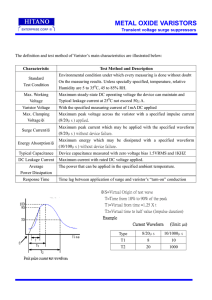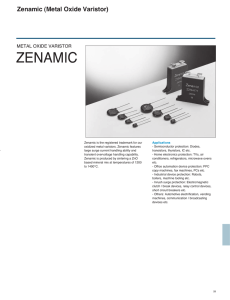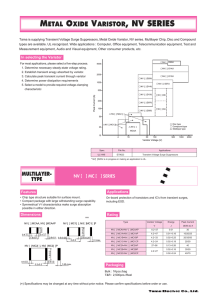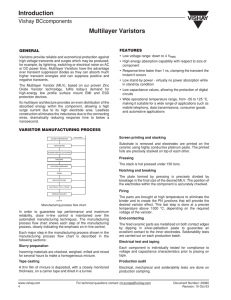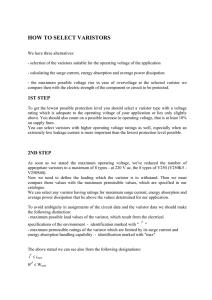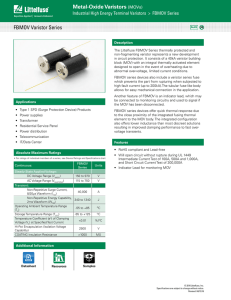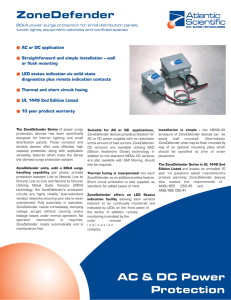Validating surge test standards by field experience: High
advertisement
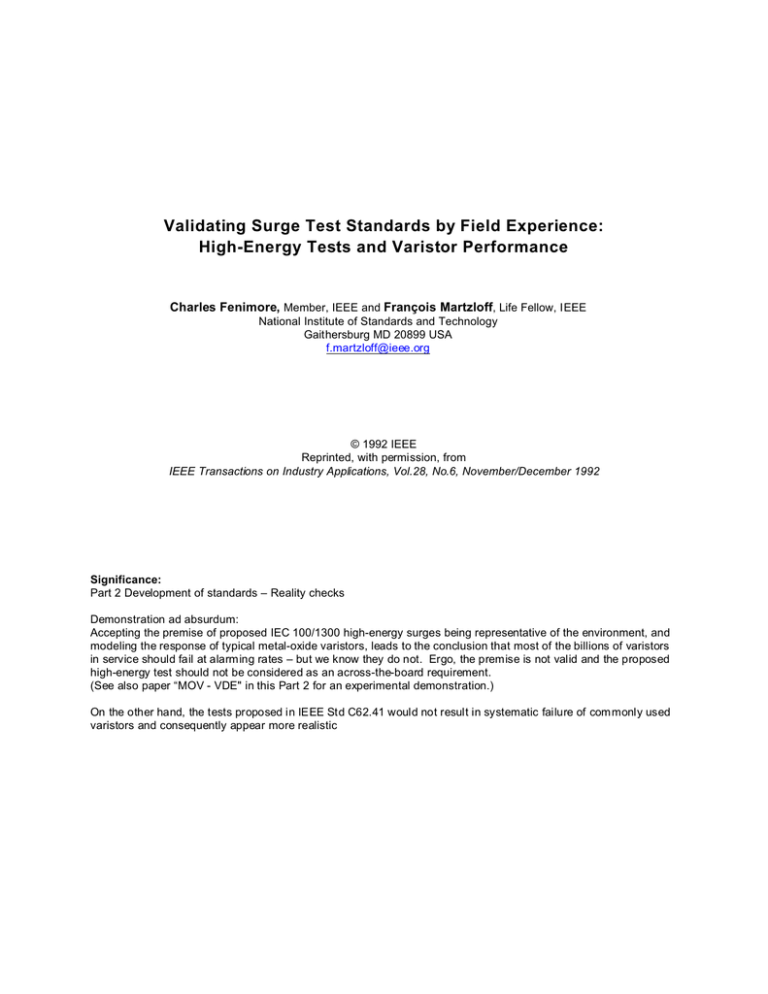
Validating Surge Test Standards by Field Experience: High-Energy Tests and Varistor Performance Charles Fenimore, Member, IEEE and François Martzloff, Life Fellow, IEEE National Institute of Standards and Technology Gaithersburg MD 20899 USA f.martzloff@ieee.org © 1992 IEEE Reprinted, with permission, from IEEE Transactions on Industry Applications, Vol.28, No.6, November/December 1992 Significance: Part 2 Development of standards – Reality checks Demonstration ad absurdum: Accepting the premise of proposed IEC 100/1300 high-energy surges being representative of the environment, and modeling the response of typical metal-oxide varistors, leads to the conclusion that most of the billions of varistors in service should fail at alarming rates – but we know they do not. Ergo, the premise is not valid and the proposed high-energy test should not be considered as an across-the-board requirement. (See also paper “MOV - VDE" in this Part 2 for an experimental demonstration.) On the other hand, the tests proposed in IEEE Std C62.41 would not result in systematic failure of commonly used varistors and consequently appear more realistic IEEE TRANSACTIONS O N INDUSTRY APPLICATIONS, VOL. 28, NO. 6, NOVEMBER / DECEMBER 1992 Validating Surge Test Standards by Field Experience: High-Energy Tests and Varistor Performance Charles Fenimore, Member, IEEE, a n d F r a n ~ o i sD. Martzloff, Fellow, IEEE Abstract-New, high-energy surge tests are emerging in IEEE and IEC standards. Field experience offers a valuable criterion for validating or invalidating proposed standards. A proposal under consideration by the IEC involves so much energy that a varistor of the voltage rating commonly used in protecting load equipment, if subjected to this test, would almost certainly fail. Yet, reported varistor failure rates do not reflect such a situation. Thus, a reexamination of the premises that led to the proposed test specifications appears necessary. Proposals for high-energy tests as additional waveforms in the new version of IEEE C62.41, on the other hand, lead to current and energy levels that do not place typical varistors in immediate jeopardy. Thus, they appear more consistent with field experience. A, NATURAL approach in defining the surge tests to e performed on any equipment is to attempt duplicating the conditions observed in site measurements. However, this approach would lead to a situation where general conclusions are drawn from limited measurements of specific surge occurrences. It has, in fact, led to a multitude of proposals for test standards that may subsequently be applied outside of their original, correct context because no other standard is available at the time. An example of this situation may be developing with the proposal by Technical Committee 77 of the International Electrotechnical Commission (IEC) for a high-energy 100/1300-ps surge test. To evaluate the effects of various proposed or existing high-energy stress tests on commonly used varistors, this paper presents a simple yet effective model of a surge generator. The evaluation proceeds by quantifying the current through the varistor and the corresponding energy deposited in the varistor. The computed results are compared with the published device ratings to predict the likelihood of failure. This likelihood is then compared Paper IPCSD 90-40, approved by the Power Systems Protection Committee of the IEEE Industry Applications Society for presentation at the 1990 Industry Applications Society Annual Meeting, Seattle, WA, October 7-12. This work was supported by the Building Industry Consulting Service International (BICSI) and by the U S . Army Research, Development, and Engineering Center. Manuscript released for publication September 24, 1991. The authors are with the Electricity Division, National Institute of Standards and Technology, Gaithersburg, MD 20899. IEEE Log Number 9203290 with the available information from field experience on failure rates. Any immunity test should be conducted with an objective that is more subtle than the goal to "duplicate the environment." A test stress is applied to a device not to demonstrate that it can survive any of the stresses that it will encounter in nature but only to demonstrate for the benefit of both manufacturer and purchaser that the device can survive an agreed-on, simple, and reproducible stress. From surviving the test stress, the inference is made, subject to confirmation by field experience, that the device does have the ability to survive the infinite variety of stresses that it will encounter during its life in the real world. In other words, simple test stresses are useful because they can be reproduced over a period of time at the same facility and between facilities, providing a common language and a standard of comparison that is essential to conduct orderly transactions. Test standards should not, however, be misconstrued as representing natural phenomena. They are effective only if they discriminate between those devices with a potential for long field survival and those that are likely to fail. The proposed 100/1300-ps IEC test should be reexamined with this philosophy in mind because it appears that commonly used varistors would be expected to fail when subjected to this test. Anecdotal experience does not support the prediction of failure in the field, raising questions as to the general validity of this test. On the other hand, high-energy tests derived from new proposals contained in the revised version of IEEE Std. C62.41 do not lead to contradiction between field experience and predicted test results. PROPOSED IEEE AND IEC HIGH-ENERGY TESTS Metal-oxide varistors that suppress surges by absorbing energy have proliferated in low-voltage ac power circuits. Consequently, new high-energy tests have been proposed to assess the ability of these varistors to withstand the corresponding stress. In a major revision of the IEEE Guide C62.41 [I] (emerging as a Recommended Practice [2]), an additional waveform has been proposed to assess this ability. The proposal is a 10/1000-ps surge, with three "system exposure" levels, which are defined below. The IEC Technical Committee TC77 is considering a 0093-9994/92$03.00 0 1992 IEEE FENIMORE AND MARTZLOFF: VALIDATING SURGE TEST STANDARDS BY FIELD EXPERIENCE surge test requirement based on the scenario of currentlimiting fuses clearing a fault at the end of a cable, where the energy trapped in the system inductance causes a large transient at the time the fuse interrupts the current [31. That scenario was first described and quantified by Meissen [4] and incorporated in German Standard VDE 0160 [5]. The new C62.41 Recommended Practice proposes, among other waveforms, a high-energy stress defined by an open-circuit voltage and a source impedance at three "system exposure" levels. For the "low exposure" level, no high-energy stress is proposed; for the "medium exposure" level, the surge environment involves a crest of two times the system peak voltage with a source impedance of 1 0. For the "high exposure" level, the crest is 2.3 times the system peak voltage, whereas the source impedance is only 0.25 0. The IEC proposal appears to be based on the VDE 0160 standard, which specifies the direct discharge of a large capacitor-thousands of microfarads-into the equipment under test (EUT). The VDE test procedures are not quite clearly outlined at this point but might be interpreted as readjusting the capacitor charging voltage after connecting the EUT to the surge generator in order to maintain the specified test voltage across the EUT. That approach would be diametrically opposed to the generally accepted practice of performing a surge test with a generator having the capability of delivering a well-defined open-circuit voltage and short-circuit current or an open-circuit voltage associated with a specified source impedance (see Fisher and Martzloff [6] and the IEEE Guide on Surge Testing [7]). Another ambiguity in the VDE 0160 test specification is that it might be acceptable to perform a test where the voltage waveform is less than the specification, provided that 80% of the energy stored in the surge generator capacitor is delivered to the EUT. However, there is no provision in the test procedure for measuring this energy, and it is doubtful that this condition can be achieved with a surge generator containing the parallel resistor that is necessary to achieve the specified rate of decay (or duration of the tail of the wave) when the EUT offers a high impedance. Metal-oxide varistors offered by manufacturers include ratings of 130 V rms for applications in 120-V systems and 250 V rms for application in 220-V systems. The motivation for using these varistor ratings is, of course, the desire to provide the lowest possible clamping voltage to protect sensitive equipment. A paper presented at the Ziirich EMC Symposium suggests that premature varistor aging may result from this close clamping (see Martzloff and Leedy [8]). However, the 130- and 250-V varistor ratings are still widely used by equipment manufacturers who take the position that they are not afflicted by unacceptable failure rates. Thus, the authors accept that position as reflecting actual field experience and will apply it as a criterion for validating or questioning the proposed high-energy test standards. - - This paper reports the results of modeling the application of a surge test to a family of commonly used varistor sizes (14, 20 and 32 mm in diameter). For each varistor size, the computations were performed for three levels of manufacturing tolerances on the varistor: nominal value, - lo%, and + 10%. A varistor with its clamping voltage at the maximum acceptable tolerance level (the level shown on published I - V curves) will tend to absorb less energy than a varistor with a lower clamping voltage because it will divert current for a smaller part of the surge. The maximum energy deposition in the varistor will occur for a varistor having the lowest acceptable clamping voltage (typically 20% below the maximum), as indicated by the 10% tolerance on varistor nominal voltages. Should the test generator parameters be at the most severe conditions within its uncertainties (higher peak voltage and longer duration than nominal within allowable tolerances), the stress on the varistor would be even greater. The circuit model used in the computations reported in this paper is a simple capacitor-discharge circuit that can produce the 10/1000-ps waveform of C62.41 or the 100/1300-ps waveform of VDE 0160, where each has the appropriate selection of the components values. The modeling results, which are discussed in detail below with supporting information in the Appendix, indicate that the smaller size varistors would not be damaged at the "medium exposure" level of C62.41 but would be damaged at the "high exposure" level. The 32-mm varistor would easily accept several applications of the "high exposure" level, whereas the 20-mm varistor would have a limited life. On the other hand, few varistors will survive the VDE 0160 stress. Table I presents this information in the form of the number of surges that a varistor can survive for the three sizes and three tolerance values of varistors and for the three type of tests: VDE 0160, C62.41 "high exposure," and C62.41 "medium exposure." The results with C62.41 are in good agreement with anecdotal (unpublished) field experience, that is, 14-mm varistors installed at the service entrance are often in jeopardy, 20-mm varistors have a better chance, and 32-mm varistors are generally successful. Failure rates are not reported formally in the literature, but anecdotal information does circulate. The response of industry to the Ziirich paper alerting the community to the risk of premature aging caused by repeated swells [a] was that 20- and 32-mm varistors do not suffer from an unacceptable or alarming failure rate. The predicted survival rates of Table I appear to be consistent with actual field experience, thus validating the stress levels proposed by IEEE C62.41. In contrast, for the VDE 0160 stress, the predicted survival rate is so low that a conclusion appears inescapable: The VDE 0160 stress involves an exceptionally high energy level, making the application of the test questionable if interpreted as a general requirement. The authors do not question the scenario leading-.. a to this stress level but do cluestion the - ~ IEEE TRANSACTIONS O N INDUSTRY APPLICATIONS. VOL. 28, NO. 6, NOVEMBER / DECEMBER 1992 1236 TABLE I PREDICTED NUMBER OF HIGH-ENERGY SURGES THAT A VARISTOR CANSURVIVE AS A FUNCTIONOF SIZEAND CLAMPING VOLTAGE TOLERANCE Varistor Clamping Size Voltage mm Tolerance VDE 0160 Class 2 C62.41 High none none none none none 1 none 1 5 none 1 8 1 3 20 8 80 800 C62.41 Medium Fig. 1. Four-component circuit for 10/1000- and 100/1300-ps surge modeling. 80 3000 > loh 500 8000 "indefinite" 20 000 200 000 "indefinite" IEC proposal to require an across-the-board test at that level for all equipment. The dramatic effect of the tolerance value on survival rate is also apparent. Greater reliability can be achieved if users would accept-better yet, request-a slightly higher clamping voltage than the lowest clamping voltage offered by the manufacturers of varistors and by the manufacturers of packaged suppressors. The normal practice in surge testing of low-voltage equipment, as described in the IEEE Guide on Surge Testing 171, is to specify an open-circuit voltage and a short-circuit current to be delivered by the surge generator. With these two parameters specified, the surge generator is considered to be defined for any test involving a specimen of high impedance (typically insulation) or low impedance (typically a surge diverter). For the unidirectional surges of 10/1000 and 100/1300 ps, a simple four-component model circuit can produce these waveforms. An actual surge generator, of course, requires careful attention to avoid problems of parasitic impedances, but the simple circuit model of Fig. 1 can deliver the required waveforms, as shown in Fig. 2 for the case of the nominal C62.41 10/1000-ps waveform. In the specification of that waveform, the tolerances allowed by C62.41 recognize the fact that the open-circuit voltage will inescapably have a longer duration but shorter rise time than the short-circuit current. Because the high-energy aspect of this test makes the current waveform the most significant parameter, the values of the components in the model were selected to most closely approximate the nominal 10/1000 ws for the short-circuit current while allowing the open-circuit voltage to go to the longest duration permitted by the tolerances. For the VDE 0160 model, the values of the components were selected to comply with the 6000-pF requirement while producing the specified open-circuit voltage. In predicting varistor failure rates, the model can take into consideration the possible combinations of manufacturing tolerances on the varistors and the uncertainties of the test (which is something that is more difficult to do by 0 - 0 0 1 TIME (ms) 2 Fig. 2. Open-circuit voltage V and short-circuit current I produced by circuit model with parameters set for the C62.41 10/1000-ps waveform. tests on random samples). In the simple computations reported here, three cases have been computed with the varistor at the midpoint and the two extremes of its manufacturing tolerance. The surge generator parameters were set to produce the nominal current waveform in order to make a midrange rather than a worst-case prediction. The conclusions on survival rates and validation of the proposed tests presented above would not be dramatically affected if the surge generator parameter tolerances were included in the computation. The component values of the circuit shown in Fig. 1 may be selected to generate the desired waveforms of the various standards. The selection method is described below. In order to determine the response of the circuit with the nonlinear varistor, numerical techniques are used as shown in the second step below. In the circuit of Fig. 1, the capacitance C is charged to an initial voltage q.. The surge generator has a series resistance R, and a parallel resistance R,. A small inductance L is tuned to provide the specified rise time. This simple LRC circuit is described by a characteristic equation where R is defined below. The two decay constants are The response of the circuit is a "double exponential" waveform [9]. Using the allowed tolerances of C62.41 for the model, the waveshape of the short-circuit current (in which case R is R,) was set at 10/1000 ps. For the open-circuit voltage (in which case R is R , + R,), the maximum FENIMORE AND MARTZLOFF: VALIDATING SURGE TEST STANDARDS BY FIELD EXPERIENCE duration allowed by C62.41 is 2000 ps. The decay times, which are expressed as full width at half maximum (FWHM) for these two waveforms are designated as t, and t,, respectively. The effective source impedance is defined in C62.41 as the ratio of the peak open-circuit voltage Vp to the peak short-circuit current I,. Its value Z = %/Ip has the dimension of an impedance. Because the time constants are widely separated, the determination of the circuit component values from the values of t,, t,, Z, and Vp can be simplified to produce approximate values. The characteristic decay values A + and A- are given by In particular, for long times t, the short circuit current I,, and open-circuit voltage Voc,are given by Applying a logarithm yields L E R tR log .9 - log . l R . tR log 9 ' -- The expressions (1)-(5) uniquely define the characteristics of the circuit for given values of the time constants, the source impedance, and the peak open-circuit voltage. With the parameters of the model test circuit thus defined, the solution of the response of the current and energy in the varistor is obtained numerically using the ordinary differential equation package PLOD [lo]. The varistor is presumed to contain an internal series resistance R, and have the I-V relationship The first-order system of equations to be solved is given by the definition of the capacitor current I and by Ohm's law At half maximum, one has and t, = log2. ( R , + R,) . C . The varistor current I, and I are related by (6) and by With a small value of the inductance and By exploiting this relationship, a direct numerical solution for the varistor current is possible. In addition, the energy in the varistor Em is found by integrating These relations lead to the four equations: The initial charge is given by C . T/,, and the initial current and energy in the varistor are zero. The computations were performed for the two C62.41 exposure levels and for the maximum VDE 0160 stress, as described below. MODELING RESULTS C62.41-10/1000- p s Stresses The inductance is determined by considering the 10-90% rise time tR. The widely separated time constants allow the fast component of the current to be estimated by at short times t. To evaluate the effects of the test on varistors, a simple model of an equivalent circuit of the varistor is connected to the terminals of the model generator. The charging voltage of the generator is, of course, left unchanged. For the range of frequencies involved in these waveforms, the only two significant elements of the varistor equivalent circuit (Fig. 3) are the pure varistor R,, ( I = kV") and the series resistance R,,, R, in the model. The parallel resistance R,,,, capacitance C, and the series inductance IEEE TRANSACTIONS O N INDUSTRY APPLICATIONS, VOL. 28, NO. 6, NOVEMBER / DECEMBER 1992 (LEAD INDUCTANCE1 Fig. 3. Equivalent circuit of a varistor (Source: [14]). L of the complete equivalent circuit can be neglected. Three diameters of 130-V rated varistors were considered, each with its characteristic clamping at - 10,0, and + 10% of the nominal value published by one manufacturer. Fig. 4 shows the type of plots obtained from the model where the current through the varistor and the cumulative energy deposited in the varistor are computed as a function of time. Showing the complete set of results for all combinations would require excessive space; a summary of the results is presented in the Appendix. In the typical example of Fig. 5, three curves show the cumulative energy for a 14-mm varistor with nominal rating of 130 V rms and three tolerance values - 10,0, and 10% clamping voltage when exposed to the C62.41 "high exposure" stress level. 0 1 TlME (rns) Fig. 4. Energy deposition E and current I in a 20-mm varistor with nominal clamping characteristic (0% tolerance) during the "High Exposure" 10/1000-fis C62.41 surge. 50 loo/ 1300-ps Stress Fig. 6 shows the parameters of the 100/1300-ps surge, Class 2 described in the most recent amendment to VDE 0160 [I11 and in the IEC proposal [3] . The voltage level is specified as 2.3 times the peak of the ac power system voltage. (The amendment also cites a Class 1 category with a level of only 2.0 times the peak of the ac power system voltage and a shorter duration). Accepting for the moment the premises that led to the specification of this test, the authors applied the same circuit model used for the IEEE waveforms to produce the specified VDE waveform with an energy storage capacitor having the value specified in the latest amendment to VDE 0160. (Earlier versions of the VDE 0160 standard suggested a 25 000-pF capacitor. In the amendment, this value has been scaled down to a range of 700 to 6000 p F , perhaps implying that the issue is still unsettled, and thus, the IEC proposal is still open to feedback from users.) In this case, because the VDE places emphasis on maintaining the voltage waveform, the model parameters were set to obtain an open-circuit voltage close to the 100/1300-ps values, with the exception of the resulting short-circuit current, for which VDE 0160 does not specify a value. Fig. 7 shows the open-circuit voltage and short-circuit current computed by the model. The computations were performed for the 250-V rms rating because the VDE 0160 does not provide specifications for system voltages of less than 220 V rms. Details of the results are presented in the Appendix together with the corresponding results from the C62.41 stress levels. I I I ~ I I I I I Rating of l4mm varistor _ - 10% - +lo% + VDE 0160 2 0 1 TlME (ms) 2 Fig. 5. Energy deposition in 14-mm varistors at - 10, 0, and + 10% values of clamping characteristics during a "high exposure" 10/1000-ps C62.41 surge. Fig. 6. Voltage waveform of the 100/1300-ps surge specified by VDE 0160 and proposed by IEC (Source: [5]). O L O TIME (ms) Fig. 7. Open-circuit voltage V and short-circuit current I produced by model with parameters set to approximate the VDE 0160 voltage waveform. FENIMORE AND MARTZLOFF: VALIDATING SURGE TEST STANDARDS BY FIELD EXPERIENCE TABLE I1 SINGLE-PULSE RESULTSAND RATINGS (IN JOULES) Typical manufacturer specifications [I21 include a joules rating for maximum single pulses; however, industry standards (Section 6, IEEE Standard on Varistor Test Specijications [131) raise some questions on the application of such a simple criterion. The cumulative energy levels for the three varistor sizes (each at three tolerance levels) were computed with the model for the C62.41 and VDE 0160 stress levels. The results are shown in Table 11, together with the typical, single-pulse joule rating published for these sizes. By using this somewhat oversimplified joule criterion (more than 10% change in nominal voltage may occur if joule rating is exceeded), it would appear that only the 14- and 20-mm varistor, for the low values of tolerance, might be in jeopardy. Using the criterion of "pulse rating" proposed by manufacturers [Ill, [14], where the current peak and duration are taken into consideration leads to more detailed and reliable conclusions, which also agree with field experience (see Martzloff [15]). Therefore, the current peak and its duration (FWHM) were also computed for the nine combinations of varistor parameters and compared with the "pulse rating" corresponding to the duration and peak in each case. The detailed results, which are the basis for the summary of Table I, are presented in tabular fashion in the Appendix, together with a discussion of the finer points of the analysis. 1) Predictions of the impact of the 100/1300-ps surge test proposed by the IEC and based on the VDE 0160 standard show that the millions of varistors in service should experience a greater failure rate than that indicated by available information on actual field failures. This inconsistency raises serious questions on the proposed requirement of such a severe test to a wide range of equipment. Furthermore, the lingering ambiguity in the VDE 0160 standard (and, consequently, in the IEC proposal) on whether to set constant open-circuit voltage or to adjust the voltage while the specimen is connected needs to be clarified. A constant, specified open-circuit voltage combined with a well-defined source impedance is the generally accepted practice in surge testing. 2) The energy levels and currents resulting from application of a waveform described in the revised IEEE C62.41, on the other hand, range from benign for typical large varistors to severe for small varistors. Thus, this set of stress levels appears to be more consistent with field experience, at least as inferred from available anecdotal information. 3) Although the authors do not question the validity of the fuse-blowing scenario, which is the basis for the VDE 0160 and proposed IEC test, they recommend a critical VDE 0160 C62.41 ance Class 2 250V 130 V O/C varistor varistor Varistor Size Toler- mm 14 -10 1 212 High C62.41 Medlurn 130 V 1 43 NOTES: 1. Five numbers are printed In bold face in the results columns for two values of tolerances in the 14-mm and 20-mm varistors. These vdues exceed the rating of the varistor, and thus would indicate a high likelihood oi failure at that stress level 2 The varistor model postulates the same I = kVm relation for the three ratings, with a series re^ nstance that decreases as the hameter o i the varistor increases. The lower serles resistance invites a greater current diversion into the varistor in the upturn region o i the I V characteristic, where its effect is more noticeable, especially for the VDE 0160 and the lower tolerance case for the varistors review of the statistics of the occurrence of fuse blowing, the use of varistors with low clamping voltage, and the distribution of actual clamping voltage within manufacturing tolerances. They also urge all users to share information on the observed failure rates and thus attain a broader perspective on these issues. This Appendix provides a summary of the 54 separate computations made to determine the current in the varistor resulting from the three high-energy tests discussed in the paper. Three varistor sizes were considered (14, 20, and 32 mm), and their "pulse rating" obtained from [12] and [14]. The 32-mm size has been dropped from the current product line of [I21 and might appear obsolete. However, it was selected because it has been applied in the past [14], and thus, more field experience is available for that size than for the 40-mm size, which is the present offering. The computed results are presented in Table A1 for the VDE 0160 Class 2 and the C62.41 "high exposure" and "medium exposure7' stresses. In each major section of the table, the computed current peak and FWHM are tabulated. Next to these computations, the corresponding current peaks are shown from the "pulse ratings" in [12] or [14] for the computed duration and for 1, 10, and 100 applications of that peak of current pulse. The usual description of a unidirectional surge is based on the FWHM, and therefore, the computations of the current in the varistor were aimed at characterizing this description of the current waveform. However, the "pulse rating" curves in both [I21 and [I41 are based on an "impulse duration" defined as the time from virtual origin of the wave and the virtual time to half value. In the case of the C62.41, with a front time of 10 ,us and a FWHM of 1000 ps, the difference between the FWHM and the "impulse duration" is negligible. In the case of the IEC 100/1300-ps waveform, the difference is more significant, IEEE TRANSACTIONS ON INDUSTRY APPLICATIONS, VOL. 28, NO. 6, NOVEMBER / DECEMBER 1992 TABLE A1 MODELING RESULTS VERSUSDEVICERATINGS-CURRENT AND DURATION VARISTOR DIA mm VDE 0160 = 10011300 ~s 2.3 x 220 x 1.4; 6000 YF; 250-V varistor IEEE C62.41 10/1000 ps "High" 2.3 x 120 x 1.4; 0.25 n; 130-V varistor IEEE C62.41 10/1000 ps 'Medium" 2 . 0 120 ~ x 1.4; 1 . 0 ~ ; 130-V varistor Tolerance of Pulses in Columns of Pulses in Columns 'Adjustment of approximately half of the rise time made to account for the difference between the computed FWHM and the "virtual duration" used in manufacturers specifications. For the short rise time of the C62.41, the difference IS negligible. "When allowable peak current for the wrresponding duration and number of pulses exceeds the rated peak current at that duration, the varistor IS deemed in jeopardy; this situation is shown by shading the wrresponding area in the rating columns. The unshaded areas represent "survival" of the varistor through the high-energy stress. IMPULSE DURATION -In Fig. AI. Typical published family of "pulse rating" curves showing amplitude, duration, and number of allowable pulses. and therefore, the comparisons of Table A1 include a 40-ps adjustment in the duration (about half of the rise time). The peak values of the current shown in the table that exceed the "pulse rating" have been identified by shading the area in the columns. At a glance, it becomes apparent that the survival rate to a VDE 0160 exposure can be expected to be extremely low; it will be moderate for the C62.41 "high exposure7' and will be at its maximum for the C62.41 "medium exposure" stresses. ACKNOWLEDGMENT The authors acknowledge the contribution of T. Key in presenting this paper at the 1990 Annual Meeting of the Industry Applications Society when, on short notice, they were unable to travel to Seattle. REFERENCES [I] ANSI/IEEE C62.41-1980, Guide on Surge Voltages in Low-Voltage ac Power Circuits. [2] ANSI/IEEE C62.41-1991, Recommended Practice on Surge Voltages in Low-Voltage ac Power Circuits. IEC Document 7 7 ~ ( ~ e n t r Office)4, al Oueruiew on Electromagnetic Compatibility-Immunity Tests. W. Meissen, "uberspannungen in Niederspannungsnetzen," Elektrotechnische Zeitschrift, vol. 104, 1983. VDE 0160 Ausriistung von Starkstromanlagen mit elektronischen Betriebsmitteln, May 1988. F. A. Fisher and F. D. Martzloff, "Transient control levels: A proposal for insulation coordination in low-voltage systems," IEEE Trans. Power App. Syst., vol. PAS-95, 1976. ANSI/IEEE C62.45-1987, Guide on Surge Testing for Equipment Connected to Low-Voltage ac Power Circuits. F. D. Martzloff and T. E. Leedy, "Selecting varistor clamping voltage: Lower is not better!," in Proc. 1989 Zurich EMC Symp. A. Greenwood, Electrical Transients in Power Systems. New York: Wiley-Interscience, 1971. E. Argon, I. L. Chang, G. Gunaratra, D. K. Kahaner, and M. A. Reed, "Mathematical software: PLOD," IEEE Micro, vol. 8, no. 4 pp. 56-61, Aug: 1988. VDE 0160A1 Anderung 1 zu DIN VDE 0160/05.88, Apr. 1989. Transient Voltage Suppression Decices, Harris Corp, 1990. ANSI/IEEE C62.33-1982, IEEE Stand. Test Spec. Varistor SurgeProtectiue Decices. Transient Suppression Manual, 5th Ed., General Electric Company, 1986. F. D. Martzloff, "Varistor versus environment: Winning the rematch," IEEE Trans. Power Deli~sety,vol. PWRD-1, no. 2, Apr. 1986. Charles Fenimore (M'88) received the B.S. degree from Union College, Schenectady, NY, in 1966 and the Ph.D. degree from the University of California, Berkeley, in 1978. He is an applied mathematician in the Electricity Division of the National Institute of Standards and Technology, Gaithersburg, MD. His interests include modeling and computing the nonlinear characteristics of high-energy/highvoltage electrical systems. He is the author of numerous papers on the breakdown of dielectric liquids, high-voltage measurements, and the solution of partial differential equations. Dr. Fenimore is a member of the Dielectrics and Electrical Insulation Society and the Circuits and Systems Society of the IEEE. FENIMORE AND MARTZLOFF: VALIDATING SURGE TEST STANDARDS BY FIELD EXPERIENCE Fraqois D. Martzloff (F'83) was born in France, where he completed his undergraduate training, and came to the United States in the 1950's to continue his graduate studies. In 1985, he joined the staff of the National Bureau of Standards (NBS, now NIST) to expand NBS activities in the field of conducted electromagnetic interference with more recent emphasis on power quality and surge protection issues. Prior to joining NBS, his long career at General Electric included high-voltage fuses and 1241 bushings development, power electronics, transient measurements, surge protection of electronics, applications of varistors, and electromagnetic interference protection. He is contributing to the work of several IEEE committees, in particular, the revision of ANSI/IEEE C62.41, Guide on Surge Voltages, into the Recommended Practice as discussed in the paper, and an update of C62.45, Guide on Surge Testing. He is serving as vicechair of the IAS IEEE Standards Coordinating Committee on Power Quality. In the IEC Technical Committee 77 on Electromagnetic Compatibility, he is serving as chair of SC77B (industrial systems) and secretary of WG2B (installation and mitigation).
